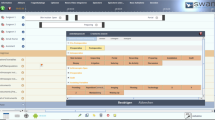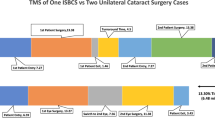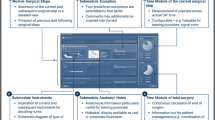Abstract
One objective of ophthalmological departments is the optimization of patient treatment services. A strategy for optimization is the identification of individual potential for advanced training of surgeons based on their daily working results. The objective of this feasibility study was the presentation and evaluation of a strategy for the computation of surgeon–individual treatment profiles (SiTPs). We observed experienced surgeons during their standard daily performance of cataract procedures in the Ophthalmological Department of the University Medical Center Leipzig, Germany. One hundred five cases of cataract procedures were measured as Surgical Process Models (SPMs) with a detailed-to-the-second resolution. The procedures were performed by three different surgeons during their daily work. Subsequently, SiTPs were computed and analyzed from the SPMs as statistical ‘mean’ treatment strategies for each of the surgeons. The feasibility study demonstrated that it is possible to identify differences in surgeon–individual treatment profiles beyond the resolution of cut–suture times. Surgeon–individual workflows, activity frequencies and average performance durations of surgical activities during cataract procedures were analyzed. Highly significant (p < 0.001) workflow differences were found between the treatment profiles of the three surgeons. Conclusively, the generation of SiTPs is a convenient strategy to identify surgeon–individual training potentials in cataract surgery. Concrete recommendations for further education can be derived from the profiles.



Similar content being viewed by others
References
Ezra DG, Chandra A, Okhravi N, Sullivan P, McDonnell P, Lee J. Higher surgical training in ophthalmology: trends in cumulative surgical experience 1993–2008. Eye [Internet]. 2010 Apr 30 [zitiert 2010 Juli 5];Available from: http://dx.doi.org/10.1038/eye.2010.54.
Ayanniyi AA, Adepoju FG, Owoeye JF. Trainee ophthalmologists’ opinions on ways to improve cataract surgical rate. Ann Afr Med. 2009;8(4):276–80.
AHRQ. Agency for Health Care Research and Quality: National Guideline Clearinghouse [Internet]. 2008;Available from: http://www.guideline.gov.
AWMF-Arbeitsgemeinschaft der Wissenschaftlichen Medizinischen Fachgesellschaften e.V. Science-based Guidelines for Diagnostics and Therapy issued by the Scientific Medical Societies in Germany [Internet]. 2010 [zitiert 2010 Juni 29];Available from: http://www.awmf-leitlinien.de/.
Henderson B, Kim J, Golnik K, Oetting T, Lee A, Volpe N, et al. Evaluation of the virtual mentor cataract training program. Ophthalmology. 2010;117(2):253–8.
Prakash G, Jhanji V, Sharma N, Gupta K, Titiyal JS, Vajpayee RB. Assessment of perceived difficulties by residents in performing routine steps in phacoemulsification surgery and in managing complications. Can J Ophthalmol. 2009;44(3):284–7.
Rogers GM, Oetting TA, Lee AG, Grignon C, Greenlee E, Johnson AT, et al. Impact of a structured surgical curriculum on ophthalmic resident cataract surgery complication rates. J Cataract Refract Surg. 2009;35(11):1956–60.
Hashimoto C, Kurosaka D, Uetsuki Y. Teaching continuous curvilinear capsulorhexis using a postmortem pig eye with simulated cataract. J Cataract Refract Surg. 2001;27(6):814–6.
Figueira E, Wang L, Brown T, Masselos K, Pandya V, Dauber S, et al. The grape: an appropriate model for continuous curvilinear capsulorhexis. J Cataract Refract Surg. 2008;34(9):1610–1.
Fisher JB, Binenbaum G, Tapino P, Volpe NJ. Development and face and content validity of an eye surgical skills assessment test for ophthalmology residents. Ophthalmology. 2006;113(12):2364–70.
Cremers SL, Ciolino JB, Ferrufino-Ponce ZK, Henderson BA. Objective Assessment of Skills in Intraocular Surgery (OASIS). Ophthalmology. 2005;112(7):1236–41.
Taylor JB, Binenbaum G, Tapino P, Volpe NJ. Microsurgical lab testing is a reliable method for assessing ophthalmology residents’ surgical skills. Br J Ophthalmol. 2007;91(12):1691–4.
Saleh GM, Gauba V, Mitra A, Litwin AS, Chung AKK, Benjamin L. Objective structured assessment of cataract surgical skill. Arch Ophthalmol. 2007;125(3):363–6.
Bhogal MM, Angunawela RI, Little BC. Use of low-cost video recording device in reflective practice in cataract surgery. J Cataract Refract Surg. 2010;36(4):542–6.
Neumuth T, Trantakis C, Riffaud L, Strauss G, Meixensberger J, Burgert O. Assessment of technical needs for surgical equipment by Surgical Process Models. Minim Invasive Ther Allied Technol. 2009;18(6):841–9.
Neumuth T, Jannin P, Schlomberg J, Meixensberger J, Wiedemann P, Burgert O. Analysis of surgical intervention populations using generic surgical process models. Int J CARS. 2010;6:59–71.
Malik R, White P, Macewen C. Using human reliability analysis to detect surgical error in endoscopic DCR surgery. Clin Otolaryngol Allied Sci. 2003;28(5):456–60.
Mehta N, Haluck R, Frecker M, Snyder A. Sequence and task analysis of instrument use in common laparoscopic procedures. Surg Endosc. 2002;16(2):280–5.
Strauss G, Fischer M, Meixensberger J, Falk V, Trantakis C, Winkler D, et al. Workflow analysis to assess the efficiency of intraoperative technology using the example of functional endoscopic sinus surgery. HNO. 2006;54(7):528–35.
Münchenberg JE, Brief J, Raczkowsky J, Wörn H, Hassfeld S, Mühling J. Operation planning of robot supported surgical Interventions. In: Proceedings of IEEE/RSJ International Conference on Intelligent Robots and Systems. IEEE Computer Society; 2001. p. 547–52.
Casaletto JA, Rajaratnam V. Surgical process re-engineering: carpal tunnel decompression—a model. Hand Surg. 2004;9(1):19–27.
MacKenzie C, Ibbotson A, Cao C, Lomax A. Hierarchical decomposition of laparoscopic surgery: a human factors approach to investigating the operating room environment. Min Invas Ther All Technol. 2001;10(3):121–8.
Jannin P, Raimbault M, Morandi X, Riffaud L, Gibaud B. Model of surgical procedures for multimodal image-guided neurosurgery. Comput Aided Surg. 2003;8(2):98–106.
Jannin P, Morandi X. Surgical models for computer-assisted neurosurgery. Neuroimage. 2007;37(3):783–91.
DOG. Veröffentlichungen der Deutschen Ophthalmologischen Gesellschaft e.V. [Internet]. Deutsche Ophthalomoligsche Gesellschaft e.V. 2009;Available from: http://www.dog.org/publikationen/index.html.
Neumuth T, Jannin P, Strauss G, Meixensberger J, Burgert O. Validation of knowledge acquisition for surgical process models. J Am Med Inform Assoc. 2009;16(1):72–80.
Neumuth T, Durstewitz N, Fischer M, Strauß G, Dietz A, Meixensberger J, et al. Structured recording of intraoperative surgical workflows. In: Horii S, Ratib O, herausgeber. Bellingham, WA: 2006. p. CID 61450A.
SPSS Inc. SPSS 15.0 [Internet]. Chicago: 2009. Available from: http://www.spss.com
Acknowledgements
The authors thank the team that supported the performance of the study and the preparation of the article at the Innovation Center Computer Assisted Surgery, University of Leipzig: Caroline Elzner and Michael Thiele. The authors also thank the surgeons that were subject to this study for their willingness to participate. ICCAS is funded by the German Federal Ministry of Education and Research (BMBF) and the Saxon Ministry of Science and Fine Arts (SMWK) in the scope of the Unternehmen Region with the grant numbers 03 ZIK 031 and 03 ZIK 032 and by funds of the European Regional Development Fund (ERDF) and the state of Saxony within the frame of measures to support the technology sector.
Author information
Authors and Affiliations
Corresponding author
Rights and permissions
About this article
Cite this article
Neumuth, T., Wiedemann, R., Foja, C. et al. Identification of surgeon–individual treatment profiles to support the provision of an optimum treatment service for cataract patients. j ocul biol dis inform 3, 73–83 (2010). https://doi.org/10.1007/s12177-011-9058-6
Received:
Accepted:
Published:
Issue Date:
DOI: https://doi.org/10.1007/s12177-011-9058-6




